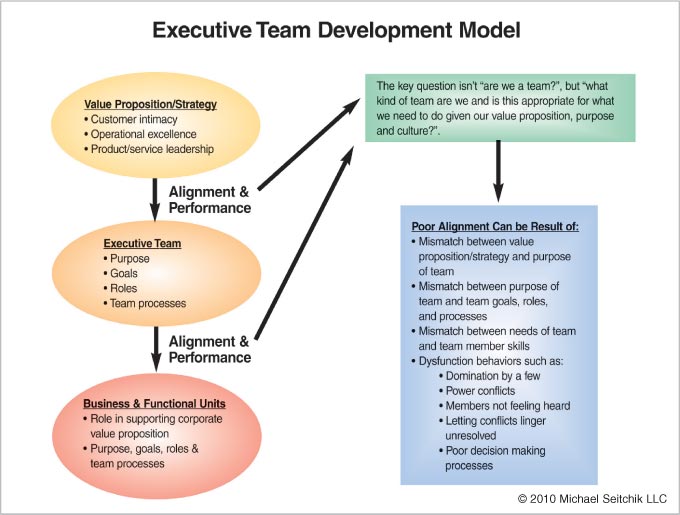 |
 |
Executive Team Development Model
Team development should be focused on executing your firm’s strategy, not on some romantic notion of what a team should look like. As a result, Dr. Seitchik’s approach as seen below in the Executive Team Development Model begins with a company’s value proposition.
 |
 The executive team’s purpose, goals and behaviors should be guided by and aligned with the organization’s overall value proposition. The executive team’s purpose, goals and behaviors should be guided by and aligned with the organization’s overall value proposition.
Michael uses the three value propositions of Customer Intimacy, Operational Excellent and Product/Service Leadership as described by Treacy and Wiersema in their best seller book, The Discipline of Market Leaders as the basis for his model.
Implications for a Customer Intimacy Approach
For example, a customer intimacy value proposition requires a company to create customized solutions for clients and customers.
Therefore, teams must:
| |
• |
Be able to cooperate across functions |
| |
• |
Be flexible enough to adapt quickly to changing customer needs |
| |
• |
Have shared decision making |
| |
• |
Allow everyone on the team to haves access to critical information about the customer |
| |
• |
Have a high level of interdependency among teams and team members (since they all must coordinate what they are doing to provide a unique solution for the customer). |
Implication for an Operational Excellent Approach
In an operationally excellent environment, processes are typically highly standardized and teams are expected to follow these guidelines and rules.
Unlike in firms with a customer intimacy strategy, high performing teams are characterized by:
| |
• |
Being highly dependent on the rules given to them by their bosses to get their work done |
| |
• |
Having decisions made centrally by the people at the top |
| |
• |
Information being shared with team members only on a “need to know” basis. |
Implications for a Product/Service Leadership Approach
With a product/service innovation value proposition, team members are highly independent of one another. Think of a typical R&D team.
They are on the team because of their individual expertise and are not expected to have much interaction with each other. Each person works on his/her area of expertise.
Decision making is highly decentralized and information sharing is controlled by individual teams and/or the individuals on the teams.
Implications for a Blended Approach
It should be noted that because organizations are a blend of the three value propositions (yet only one usually defines their competitive strategy), teams also form a variety of ways to reflect the organization’s unique combination of the three archetypal value propositions.
Michael works with clients to agree on the organization’s unique blending of the three approaches to determine the characteristics a high performing team would have in that environment.
Then, he assesses the executive team to determine fit and next steps.
A Customized Approach to Executive Team Development
Since high performing teams in a customer intimate approach need to behave very differently than high performing teams in other strategic environments, one size does not fit all.
For example, the conflict management skills needed for team members in a highly customer intimate driven organization (where cooperation and high levels of interpersonal trust are needed) may be very different from team members in a highly product innovation driven organization (with the need for relatively lower levels of cooperation and interpersonal trust).
Michael would not have the same goals for a workshop on conflict management for these very two different types of teams and, therefore, the skills the faculty would teach might be quite different.
Again, the goal of team development is to help team members gain the skills and behaviors needed to execute their strategic purpose. Team building is not a touchy feely exercise, but a serious vehicle for maximizing performance.
|
|
